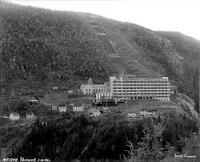Happy Thursday, everyone! Ruth Brown (Linda’s fictional war
correspondent) here reporting on a sabotage event that occurred in February
1943.
Heavy water is a type of water that is made up of a heavier
than normal hydrogen isotope. The nature of heavy water allows it to be used in
the production of nuclear energy. Prior to WWII Vemork, Norway became the home
of a heavy water manufacturing plant. Located at the Rjukan waterfall, the
facility was the world’s largest power plant when it opened in 1911. It was
converted to heavy water production in 1934.
 Because they were dabbling with nuclear weapons, the Germans
were eager to get their hands on the water. But the Norwegians were able to
move their supply to France in 1940 before to the German invasion of Norway.
However, the plant was still capable of producing heavy water, so manufacturing
continued under German occupation. The Allies quickly realized they would have
to destroy the facility.
Because they were dabbling with nuclear weapons, the Germans
were eager to get their hands on the water. But the Norwegians were able to
move their supply to France in 1940 before to the German invasion of Norway.
However, the plant was still capable of producing heavy water, so manufacturing
continued under German occupation. The Allies quickly realized they would have
to destroy the facility.
An attempt was made in October 1942. Under cover of
darkness, SOE-trained Norwegian operatives were parachuted into Norway. Then
over the course of two weeks skied their way to the Vermork facility. In
November 1942, a British force tried to land gliders on a nearby lake from
which they would commence an attack. Unfortunately the gliders crashed resulting
in several deaths of the crew. Survivors were captured and executed by the
Nazi’s.
The original group of operatives was still in place and
existed on lichen and moss throughout the winter. In February the Allies
launched another operation, and these men were able to make contact with the
first group. At a few minutes after midnight on February 23, 1943, the force
descended into the ravine, crossed the river and climbed the steep hill on the
other side. Using tunnels the saboteurs were able to get inside the plant where
they placed explosives on the electrolysis chambers before attaching a very
long fuse (allowing them enough time to escape).
The raid was
successful. The entire inventory of heavy water produced during the German
occupation was destroyed, as well as the equipment necessary to operate the
electrolysis chamber. Over 3,000 German soldiers searched the area for the saboteurs,
but all escaped. Five of the men skied to Sweden, two went to Oslo and the
other four remained in the area to conduct further resistance work.



No comments:
Post a Comment